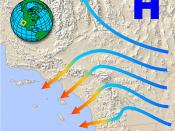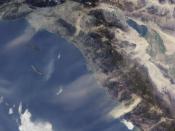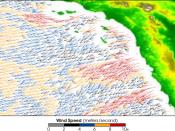In Didion's essay, "Los Angeles Notebook," she characterizes the Santa Ana winds as motivation for evil. Didion expresses this view through her imagery and diction. Didion also justifies her characterization through the structure and tone of her essay. She attributes the acts of individuals all over the world on the effects of wind. She claims that certain winds trigger a mechanistic switch that causes humans to act irrationally. Didion connects a natural phenomenon with the cause of an unconscious reaction by living organisms.
Didion's use of imagery and diction portrays the winds as an evil force that is intangible and unconscious. Didion states, "That the Indians would throw themselves into the sea when the bad wind blew." There, Didion's word choice of "bad" characterizes the winds. She later declares, "The Pacific turned ominously glossy during the Santa Ana period, and one woke in the night troubled not only by the peacocks screaming in the olive trees but by the eerie absence of surf."
In that sentence, Didion appeals to the senses of hearing and sight. Didion continues by saying, "The sky had a yellow cast, the kind of light sometimes called "earthquake weather"." Here Didion invokes the senses of sight and touch to relate that to disasters. Didion later says, "Meek little wives feel the edge of the carving knife and study their husbands' necks." Again, Didion draws out a sense of sight and touch. Didion's word choice and invoking of senses helps to establish that winds are evil and a cause for wrongdoing.
Didion also proves her theory about the wind being a switch with her tone and structure. Didion?s tone is sympathetic to a cause. She persuades a switch to her view and characterization towards the wind. Didion?s tone also has a sense that she is proving...


